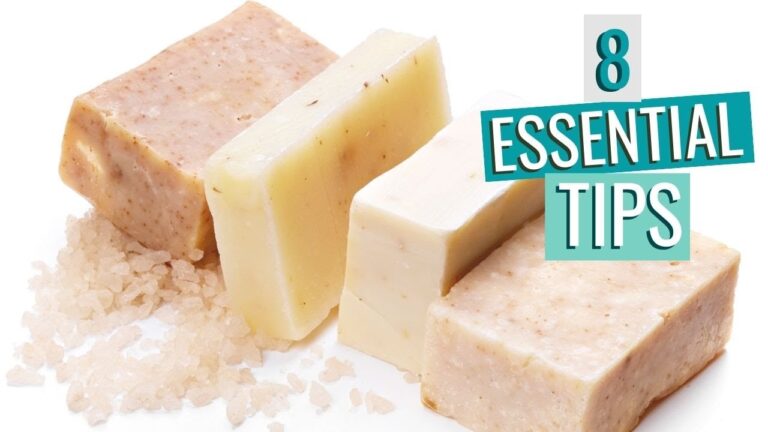In the world of artisanal skincare, small batch soap curing has become a popular and highly sought-after method for creating luxurious and high-quality soaps. This meticulous process involves carefully monitoring the ingredients and curing time to ensure a perfect balance of moisture and hardness in the final product. Join us as we explore the art of small batch soap curing and discover the secrets behind its exceptional results.
What is the shortest amount of time it takes to cure soap?
Get clean and fresh with our handmade soaps, ready to use in just 48 hours! Our soaps undergo the saponification process, where fats and alkali combine to create the perfect cleansing formula. You can trust that all our soaps are safe to use after the minimum curing time of 48 hours, making them a quick and effective choice for your daily routine.
Experience the science behind clean with our 48-hour cured soaps. Saponification is the key process that transforms oils and alkali into the soap you love, and it only takes 48 hours to complete. With this undisputed scientific fact, you can rest assured that our soaps are ready for use, providing you with a refreshing and gentle cleanse every time.
What is the curing time for soap?
Yes, soap does have a curing time, but it is typically longer than just 1 week. In fact, it takes about 4 to 6 weeks for a soap to fully dry and for the lye to be completely transformed. The curing process can vary depending on the oils and water percentage used in the recipe. For recipes with discounted water, 4 weeks may be sufficient for the soap to cure effectively.
Allowing your soap to cure for the appropriate amount of time is crucial for achieving the best results. While it may require some patience, the 4 to 6 week curing period ensures that your soap is fully transformed and ready for use. So, while 1 week may seem like a long time to wait, the end result of a properly cured soap is definitely worth it.
What is the consequence of not curing soap for a sufficient amount of time?
If you use your soap before it has fully cured, it will dissolve more quickly due to its higher water content and the fact that not all of the longer chain fatty acids have formed soap crystals at that point. It is the crystalline component of soap that is predominantly made up of longer chain soaps, which contribute to its durability and longevity.
Elevate Your Soap Game: Mastering Small Batch Curing
Upgrade your soap-making experience with our guide to mastering small batch curing. Elevate your soap game and achieve superior quality products by following our expert tips and techniques. From choosing the right ingredients to perfecting the curing process, take your craft to the next level and create luxurious soaps that will impress even the most discerning customers.
Unlock the secrets to small batch curing and transform your soap-making hobby into a professional-grade operation. With our step-by-step instructions and insider knowledge, you’ll be able to produce small batches of soap that are perfectly cured and ready to use. Elevate your soap game today and experience the satisfaction of creating high-quality, artisanal products that stand out from the rest.
Small Batch Soap Curing Made Easy: A Comprehensive Guide
Small batch soap curing is a simple yet essential step in the soap-making process. By allowing your soap to cure properly, you can enhance its quality, longevity, and overall performance. This comprehensive guide will walk you through the steps of small batch soap curing, providing you with all the information you need to ensure a successful curing process.
To start, it is important to choose a well-ventilated area with a consistent temperature for curing your small batch soaps. This will help prevent sweating and ensure even drying of the soap. Additionally, make sure to allow your soap to cure for at least 4-6 weeks, as this will allow the soap to fully harden and develop its desired characteristics. Remember, patience is key when it comes to small batch soap curing.
Finally, once your small batch soaps have fully cured, it’s time to enjoy the fruits of your labor. Your cured soaps will be ready to use, providing you with a luxurious and nourishing cleansing experience. By following this comprehensive guide to small batch soap curing, you can create high-quality soaps that are sure to impress both yourself and your loved ones.
Unlock the Secrets of Small Batch Soap Curing: Expert Tips and Techniques
Are you ready to unlock the secrets of small batch soap curing? With expert tips and techniques, you can take your soap making to the next level. By understanding the science behind curing and utilizing the right methods, you can create high-quality, long-lasting soaps that will leave your skin feeling nourished and refreshed. Whether you’re a seasoned soap maker or just starting out, mastering the art of small batch soap curing will elevate your craft and leave a lasting impression on your customers.
Incorporating small batch soap curing techniques not only enhances the quality and effectiveness of the final product, but also allows for a more personalized and artisanal touch. By taking the time to properly cure each batch, soap makers can ensure a longer shelf life, increased lather, and a more luxurious experience for their customers. Embracing this traditional method of soap making not only benefits the end user, but also supports the preservation of a time-honored craft in today’s fast-paced world.



